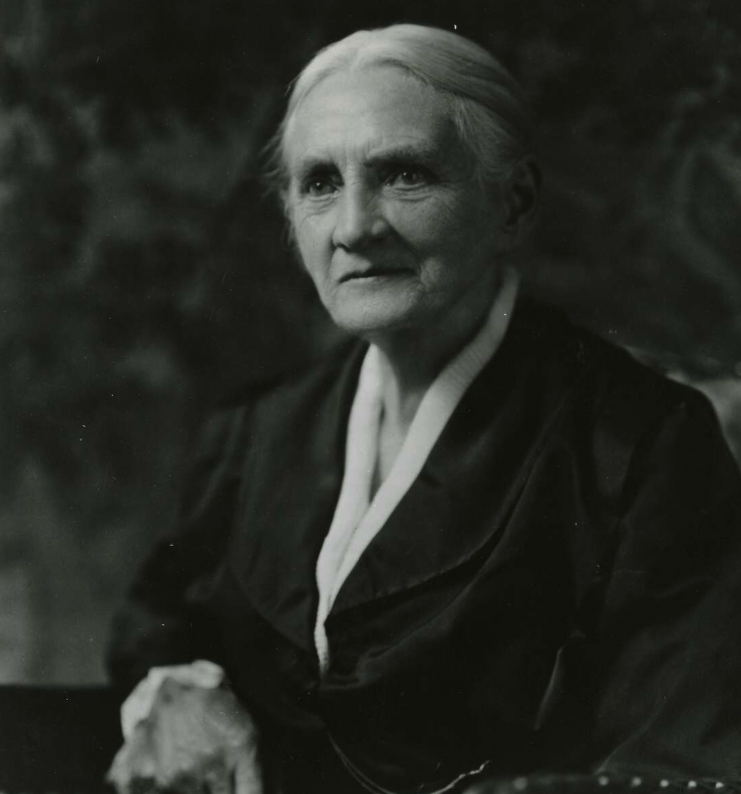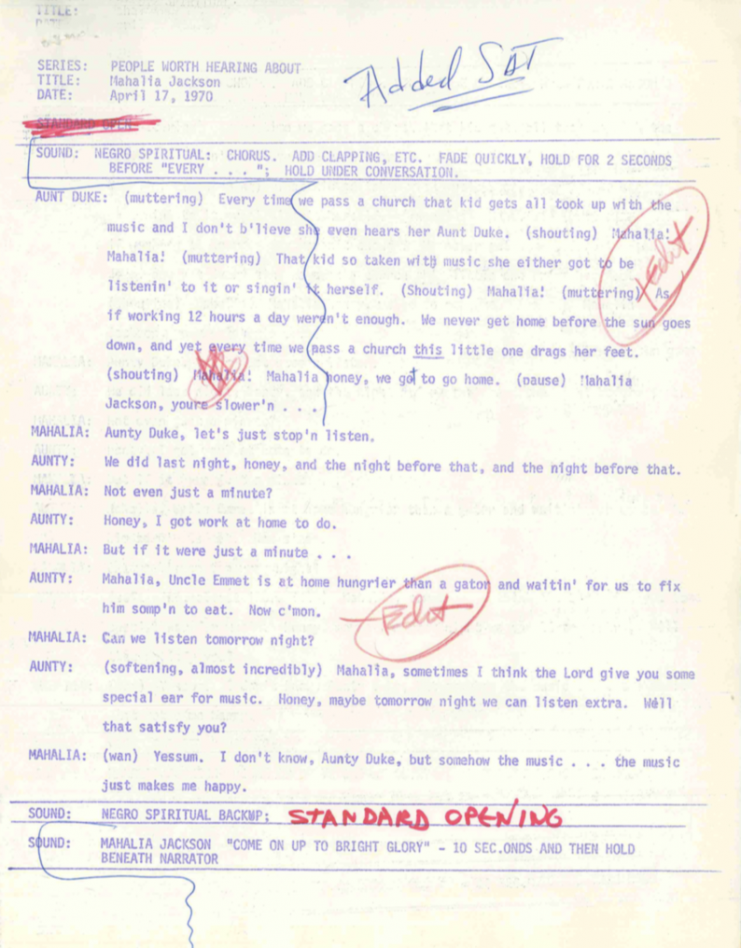You are listening to U of M Radio on your Historic Dial!
Season 3: Episode 2. Women on the Air: People Worth Hearing About
Podcast (umnradio): Play in new window | Download
You are listening to U of M Radio on Your Historic Dial podcast. Welcome to Season 3: Episode 2.
Hello, this is Rebecca here to share another historic broadcast from the archives in continuation of the Season 3 theme, “Women on the Air.” On this episode, I’ll introduce the KUOM program series, People Worth Hearing About, which aired on The Minnesota School of the Air from 1969-1979. The series, written and produced for school children in grades 4 through 6, was intended to promote cultural understanding. We’ll listen to a broadcast from the 1970s that features a notable woman in Minnesota history, and I’ll also share some correspondence from School of the Air director Betty Girling and scriptwriter Michele Cairns that provides insight into the production of educational radio programs.
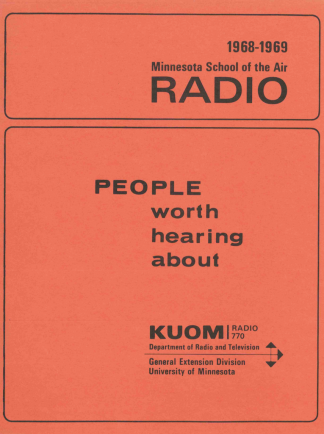
Minnesota School of the Air teacher guide for the program “People Worth Hearing About” for the 1968-1969 season.
The idea for the program series People Worth Hearing About originated with The Minnesota School of the Air director, Betty Girling. The series, which first aired from April 7 to May 23, 1969, featured daily ten-minute vignettes on 35 African Americans, selected in consultation with Maurice W. Britts, Coordinator for Human Relations at Minneapolis Public Schools. In subsequent years, profiles and interviews with American Indians, Asian Americans, Chicanos, Eskimos, Hawaiians, and women were added to the series.
In a guide produced for teachers as a supplement to the programs, Girling outlined the purpose of the series:
“… we try to introduce students and teachers to outstanding Americans, who are rarely if ever mentioned in usual textbooks. These Americans… have – for the most part – been overlooked in the writings of our history, because they were non-white, or non-male… People Worth Hearing About attempts to bring the names, personalities, problems, and accomplishments… of these outstanding “overlooked” Americans, living and dead, into thousands of classrooms via radio and tape.”
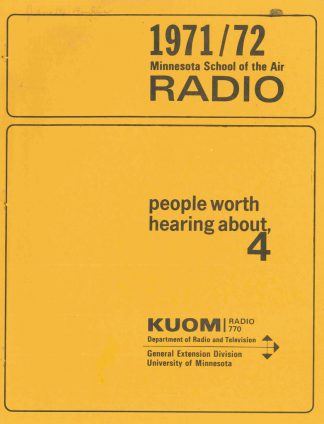
Minnesota School of the Air teacher guide for the program “People Worth Hearing About” for the 1971-1972 season.
In the 1971-1972 season, a unit devoted specifically to women was included for the first time. Eight women were selected as subjects for the episodes. Examples include Jeannette Rankin, the first woman elected to the U.S. House of Representatives, women’s rights advocate Susan B. Anthony, and Maria Sanford, the first female professor at the University of Minnesota.
Girling introduced the section on women in the teachers’ guide:
“Dear Teacher,
In America, women’s struggle for equality of citizenship, the right of self-determination, the right to vote, own property, and receive equal pay for equal work, has a history over one hundred years long. And it still continues.
Few American school children ever have the opportunity to learn of the tremendous contributions women have made to our Nation, because these contributions are either omitted entirely in our textbooks, or treated in an abbreviated fashion, minimized out of proportion to their true value.
While inequalities are slowly being corrected in texts and school materials, in laws and ordinances, in public custom, and private behavior, true equality is still a too distant goal. To speed progress toward that goal, this year’s People Worth Hearing About presents the life stories of eight women whose contributions have fundamentally affected the course of our history and institutions.”
The life story of Maria Sanford, professor of rhetoric and elocution at the University of Minnesota from 1880-1909, public lecturer, and educator, was presented to radio listeners on April 21, 1972. Let’s hear about this outstanding American woman…
Broadcast transcript
Tape: [Standard Opening – Women Singing, “Good morning, stars are rising… Bright morning, stars are rising…]
Narrator: KUOM presents, People Worth Hearing About, 10 minutes spotlighting the lives and ideas of outstanding American women.
[Bells ringing]
Narrator: In 1879, at the age of forty-three, Maria Sanford left her job at Quaker College in Swarthmore, Pennsylvania, and came to the University of Minnesota. Years later, University President Folwell declared that he was proud of having “discovered” Ms. Sanford. Students throughout her sixty-four years of teaching recall their experiences with her vividly. Especially they recall her “sunrise” classes at the University of Minnesota. Only the best students were invited to these classes. Some would rise before dawn and walk in the cold for miles in order to have the “honor” of Ms. Sanford’s sunrise class. Doubtless the stimulating nature of a class of bright students headed by Ms. Sanford made up for the difficulty of getting there. But in her memoirs, Maria Sanford recalls the one morning her students playfully rebelled.
[Sound: Music, students chattering. Interior of Classroom, Bell. Silence.]
Maria: [dignified] Good morning, students. Today we have speeches from Annette and Nancy, and a recitation from Frank. Now, since we are concentrating this week on audience control…
Howard: Ms. Sanford?
Maria: Yes, Howard?
Howard: Ms. Sanford, we’ve prepared a surprise for you. [The class laughs lightly]
Maria: Oh? [curiously] Well, what is it, Howard?
Howard: We have a poem – by John G. Saxe – we wantto recite. Lynn is going to start.
[Sound: Chair being pushed back, general laughter.]
Lynn: [uncertainty at first, but gaining confidence as Ms. Sanford and the students respond with amusement] God bless the man who first invented sleep! So Sancho Panza said and so say I.
[Laughter]
And bless him also that he didn’t keep
His great discovery to himself; nor try
To make it – as the lucky fellow might –
A close monopoly by patent right!
[Sound: Another chair being pushed back, general laughter.]
Howard: [more energetically] Yes, bless the man who first invented sleep
(I really can’t avoid the interation)
But blast the man, with curses loud and deep,
Whae’er the rascal’s name, or age, or station,
Who first invented, and went around advising
That artificial cut-off, early rising!
[Sound: General laughter.]
Margaret: (fade out) Yes, bless the man who first invented sleep
(It seems that I’m somehow repeating…)
[Sound: Interior of classroom out, music, fade.]
Narrator: To leave Swarthmore at the age of forty-three was no easy task; but Maria Sanford was no stranger to challenges. Born on December 19th 1836, in Saybrook, Connecticut, she was the third child in a family of four. For nine years she was the youngest – an alert, eager child, interested in all around her. When her brother Rufus was born in 1846, the nine-year-old Maria adopted him as her special charge. Even then, education was important to her. Besides teaching her brother all she knew, she attended a nearby country school and read the Bible exhaustively. When she was fourteen, her family moved to Meriden, Connecticut, and she began to attend the Meriden Academy. Besides her unusual thirst for knowledge, the child Maria was distinguished by an extraordinary unselfishness. A relative recorded the following incident:
Relative: Her small brother, Rufus, had always noticed that his sister, when taking from a dish of apples, reached for the one with decayed spots. He therefore supposed she liked them best. And so, one day, when he went to a neighbor’s house on an errand, and the woman asked him if he thought his family might like some apples that had begun to decay, Rufus replied at once: “Oh! Yes, I am sure we can use them, for Maria loves rotten apples!”
Narrator: When she was sixteen, Maria asked her parents if she might use the money they had saved for her marriage for an education at the Britain Normal School. This was an unusual request for a girl during the eighteen hundreds; education for women was generally regarded as unimportant. But Maria’s parents granted her request, and they were never sorry; graduating with honors at the age of nineteen, Maria Sanford so impressed the school’s principal, John D. Philbrick, that he was later to say of her:
Philbrick: Maria Sanford had uncommon energy and vigor, and was conspicuous for industry, fidelity, and earnestness. What her hands found to do, she did with all her might.
Narrator: Finishing her education, Ms. Sanford started her career of teaching. In a country school at Gilead, forty miles from her home, she began to teach at a salary of ten dollars a month. Her first triumph came when a county superintendent came to Gilead to observe her teaching; he sat all afternoon saying nothing, then left, still saying nothing. But in a meeting later that day, he told her:
Superintendent: I have been watching your children all the afternoon. You said nothing. Each one seemed to be doing exactly as he wanted to do, and each one wanted to do right.
Narrator: After teaching in Gilead, Ms. Sanford went on to teach at Middlefield and New Haven, Connecticut – then at Parkersville, West Chester, and Swarthmore, Pennsylvania – and finally, at the University of Minnesota. She left behind her a trail of admiring, capable, and influential students… such as the doctor who wrote to a friend:
Doctor: My brother tells me that Maria L. Sanford will be in West Chester soon. As an original pupil of Ms. Sanford… I am very anxious to meet her again. Forty-two years ago she taught at Parkersville and it has always been a recollection of joy when I think of that time, as she did more to create in me the love of knowledge than any teacher that I had the pleasure to know.
Narrator: And, although public speaking for women during the eighteen hundreds was generally frowned upon, Ms. Sanford also influence people by her lectures. Her dignity, earnestness, and enthusiasm, [begin fade] coupled with a strong and flexible voice…
Maria: [fade up] to fill every heart with love for all that is good and true… to kindle the soul with a longing for a noble life… to urge the individual toward accomplishment… to urge the students to do something steadily: forty years of studying birds! We should ever be seeking to grow in the direction of all good.
[Sound: Applause. Fade out.]
Narrator: On April 21st, 1919* Maria Sanford died – but not without having had a profound effect on the lives of thousands. The respect felt by those who knew this remarkable woman – first woman Professor at the University of Minnesota – is ever evident: evident in Sanford Hall, named in memory of her – and in the tributes paid to her by hundreds of former students – tributes such as the poem: In Memory of Maria L. Sanford:
Student: Thrice blessed those whose privilege it was
To call her teacher in that former time,
But happy all who from her lips have learned
The Dignity of toil, her simple creed sublime.
[*Maria Sanford died on April 21st, 1920]
[Tape: Standard closing – Women singing, “Oh where are our dear fathers… Oh where are our dear fathers… music fades.]
Narrator: People Worth Hearing About is a presentation of The Minnesota School of the Air.
Writing for your Audience
I have to admit that when I first heard this broadcast, I was a bit puzzled. I thought of all of the details of Maria’s life that the broadcast never mentioned. The story of her contributions to the University, her community, the state of Minnesota and beyond, could fill an entire season of this podcast. What about her involvement with civic improvement for the city of Minneapolis, her highly regarded public speeches, and her work with the American Indian community?
While reading through correspondence in the Betty Girling papers at University Archives, I was introduced to the particulars of production for the People Worth Hearing About series, and learned the reason why certain details about Maria – which I thought important – were not included in the broadcast. I was also reminded that I did not fit within the demographic of the intended program audience.
In an April 7, 1970 memo to scriptwriter Michele Cairns, Betty Girling revealed that the production for People Worth Hearing About was on a tight schedule, “This week and next are Armageddon weeks. You have every right to be uptight… and I’m afraid I can’t manage a relaxed calm which would provide the kind of atmosphere in which you can work…”
Girling voiced concern regarding the availability of actors to record scripted voices for episodes scheduled to air the week of April 13-17. In addition, Girling emphasized the need for a script that day in order to get copies to staff members involved with production:
“I really have to have the Waters script today because we have to Special Delivery a copy to Irv so he has it tomorrow morning and can come to the studios during his lunch hour to set up Production. No producer can hit a script cold without preparation and he – quite vehemently – hates to. On Tuesdays I have to leave at 3:30 but I will leave word with Joyce to send him the script when she leaves… OK? We can xerox him a copy… We might have to even if it were done by noon because it seems Joyce’s typewriter has momentarily died.”
Due to production requirements, Girling indicated to Cairns that the scripts for episodes profiling writer Frank Yerby, and artist Henry Ossawa Tanner were needed by that Friday, in order to record on Saturday, in time for broadcast on April 13 and 14. As a result, Girling advised to keep the programs simple, and to think of the audience:
“The Yerby and Tanner shows necessarily must be VERY simple practically speaking because there will be absolutely no editing time. What is recorded on Saturday goes on the air Monday and Tuesday. Maybe this just means using a Narrator with the author reading short snatches from his works to give flavor. (Remember… these kids are 9 years old and have never read any novel, let alone an historical one.) It seems to me here… or in any show where the meat of the person’s life is so very far from the child’s experience, it might be wiser to alter our goal of giving-the-life-story to saying here-is-a-person-who-is-really-great-as-a-writer (or whatever)… Better the child should remember the name Yerby or Tanner… than that he should get turned off completely by material he-she does not understand.”
Betty continued the memo with additional advice on writing for radio on a deadline:
“I know it denies a writer’s highest moral, but Michele… in non-print media like radio… more important than The Word, is TIME. Honey, we haven’t time for you to read books on these people. Now we have to “wing it”…get 2-3 biographical sketches… a highlight or two… the flavor of the work, and then sell the name…”
Girling referenced the script Cairns was then writing for an upcoming episode about gospel singer Mahalia Jackson, which aired on April 17, 1970:
“It is cumbers[ome], but when we have only maybe 8 minutes to vignette a person… we almost have to say in an opening narration… preferably short: “This is the story of a great singer. Her name is Mahalia Jackson… maybe you’ve heard her sing. She has always liked singing… why, years ago, even as a child, when she lived with her Aunt Duke… even then she was in love with music…’”
Girling closed the memo with a few final tips:
“If a child knew BEFORE what he is going to hear, I think there is less jeopardy in the situation for him… also if he knows WHAT to listen for he’ll get more out of it… For now… when possible keep the sentences short… and try for the picture-in-the-mind kind of description. Similes are good…”
In hindsight, the Maria Sanford broadcast, which aired in 1972, adhered to the writing style and production realities that Girling first advised Cairns to follow. In a note to a producer affixed to the top of the script, Cairns stated:
“One actor should be able to take two or three of the parts, since they don’t occur in the same scene, and most are small parts. If you don’t have actors capable of such versatility, any of the speeches of the relatives, Philbrick, Superintendent, Doctor, or former student, may be incorporated into the narration.”
After reading a draft script for the Maria episode, Betty wrote to Michele:
“Michele… I think the script on Maria S. is fine – but we need a good punch somewhere near the end about her being… was she the FIRST WOMAN teacher at the University? Rather I think she was the first FULL PROFESSOR WHO WAS A WOMAN. Was she ever Chairman of the English Dept? And… of course, Sanford Hall was named for her… as a woman’s dorm. This is the one University-connected woman we’re citing, so can you play it up just a bit?” Omit or utilize anything I may have written on the margins in reading it…”
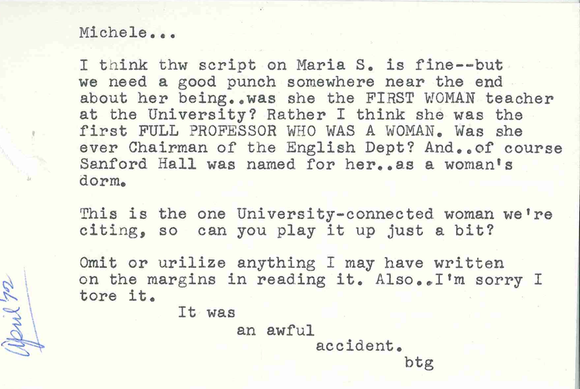
Memo from program manager Betty Girling to producer Michele Cairns regarding the Maria Sanford script.
The draft of the script with what Betty “may have written on the margins” was not included with the note. However, in Michele’s reply, she rejected a change Betty suggested in reference to Maria’s experience with the American Indian community. Michele wrote:
“I changed the ending of the Maria Sanford script to include mention of Sanford Hall and her status as first woman professor. But I disagree about the beginning. To say something like “A woman… alone… going into Indian lands” would seem to me to imply women are suspected of being less self-sufficient than men. I thought we were working against that in this series – We should assume respect for a woman as a human being capable of human endeavors.”
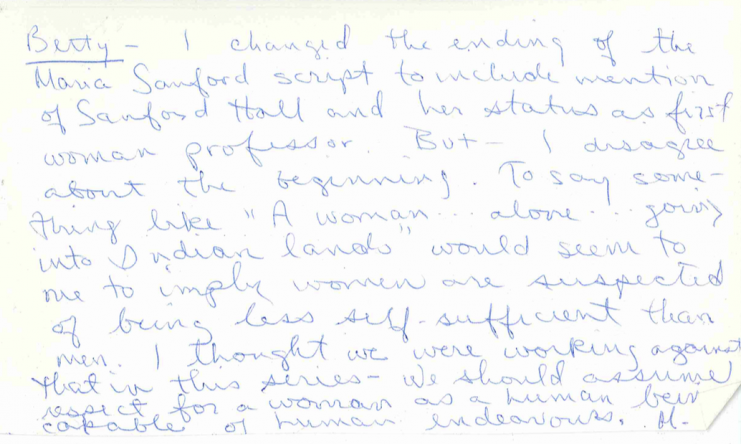
Handwritten note from KUOM producer Michele Cairns to program manager Betty Girling regarding the Maria Sanford script.
Touché, Michele.
Recordings of the program series People Worth Hearing About are available in the UMedia Archive and are listed in the finding aid for the Radio & Television Broadcasting records, under the series title in the section for The Minnesota School of the Air.
To learn more about Maria Sanford, consult the Maria Sanford papers at University Archives, or read a biography about Maria published in 1922, which is available online at the Hathi Trust. Take it from me, it’s worth it.
If you would like to hear more about women in the archives, join us at Elmer L. Andersen Library for the second program in the First Fridays season on November 2, 2018 at 12:00 p.m. presented by the Upper Midwest Jewish Archives, and the Kautz Family YMCA Archives. Light refreshments will be served prior to the program, and a tour of Andersen’s storage caverns and research center will begin after the presentations. The full First Fridays schedule and descriptions of upcoming programs can be found at the website z.umn.edu/ff18.
About this podcast
The U of M Radio on Your Historic Dial podcast is produced by University Archives and Libraries Communications for your enjoyment. Subscribe or download on iTunes or GooglePlay so you don’t miss another moment of historic Minnesota radio.
Recordings were digitized in 2016 in part with funds provided by the State of Minnesota from the Arts and Cultural Heritage Fund through the Minnesota Historical Society.
—Rebecca Toov is the collections archivist for the University of Minnesota Archives.


